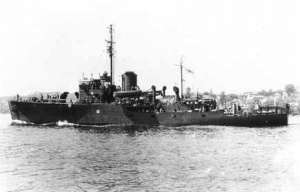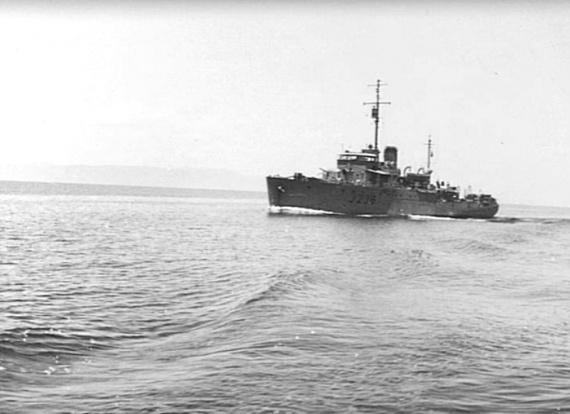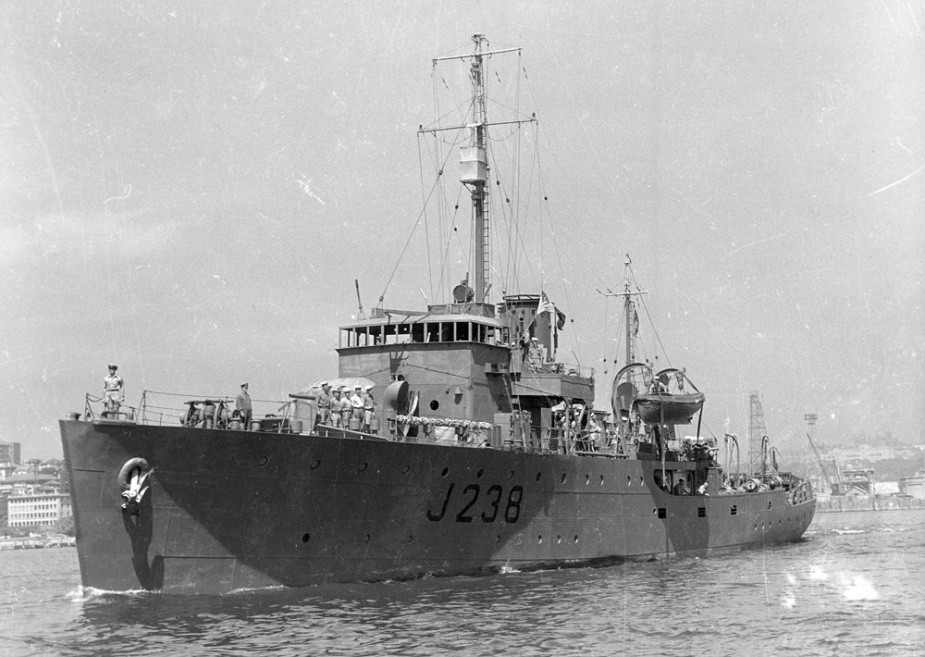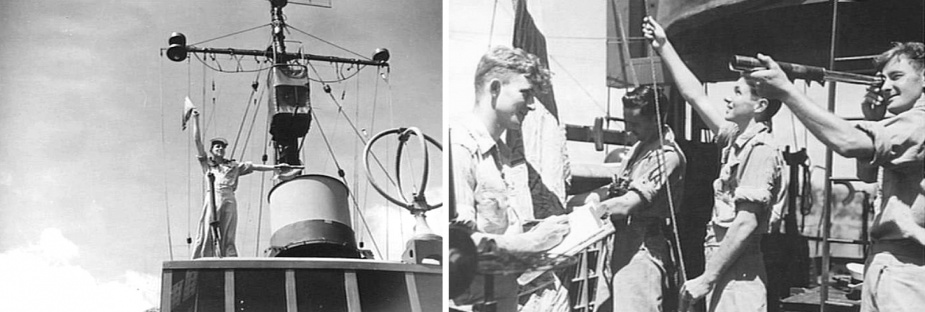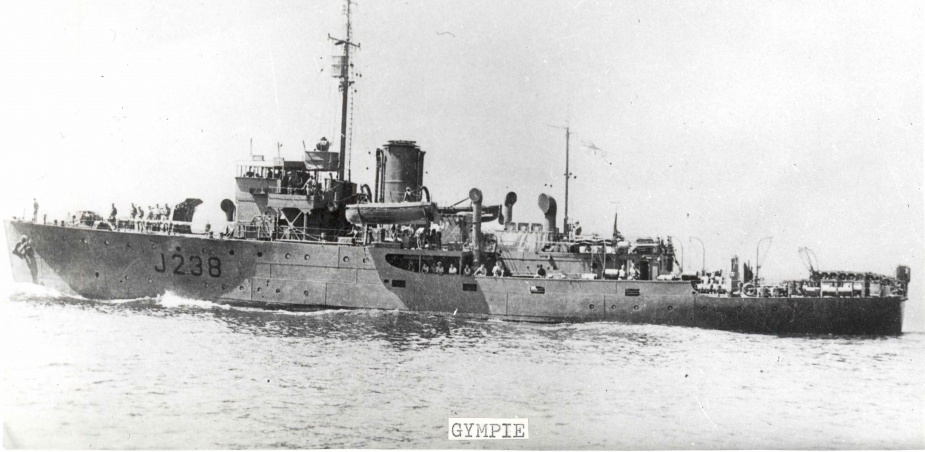HMAS Gympie
| Class |
Bathurst Class |
|---|---|
| Type |
Australian Minesweeper |
| Pennant |
J238, M238 |
| Builder |
Evans Deakin & Co Ltd, Brisbane |
| Laid Down |
27 August 1941 |
| Launched |
30 January 1942 |
| Launched by |
Mrs Deakin, wife of the Joint Managing Director of Evans Deakin & Co Ltd |
| Commissioned |
4 November 1942 |
| Decommissioned |
23 May 1946 |
| Dimensions & Displacement | |
| Displacement | 650 tons |
| Length | 186 feet |
| Beam | 31 feet |
| Draught | 8 feet 6 inches |
| Performance | |
| Speed | 15 knots |
| Complement | |
| Crew | 85 |
| Propulsion | |
| Machinery | Triple expansion, 2 shafts |
| Horsepower | 2000 |
| Armament | |
| Guns |
|
| Other Armament |
|
| Awards | |
| Battle Honours | |
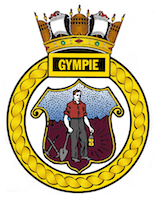
HMAS Gympie was one of sixty Australian Minesweepers (commonly known as corvettes) built during World War II in Australian shipyards as part of the Commonwealth Government's wartime shipbuilding programme. Twenty were built on Admiralty order but manned and commissioned by the Royal Australian Navy. Thirty six (including Gympie) were built for the Royal Australian Navy and four for the Royal Indian Navy.
HMAS Gympie was laid down at Evans Deakin & Co Ltd, Brisbane, Queensland on 27 August 1941. She was launched on 30 January 1942 by Mrs Deakin, wife of the Joint Managing Director of Evans Deakin & Co Ltd and was the first RAN warship to carry the name of the town in Queensland, located 160 kilometres north of Brisbane.
Gympie commissioned at Brisbane on 4 November 1942 under the command of Lieutenant Commander Charles WJ Patterson, RANR.
Following trials, Gympie assumed duty as a convoy escort vessel on the north east coast of Australia, which kept her constantly in service until February 1944. From January to June 1943 Japanese submarines were making their final attempt to halt the flow of Allied shipping to the forward areas. Eleven ships were sunk in Australian waters but none while under escort by Gympie. She did, however, render assistance to the torpedoed American ship Peter H Burnett in January 1943. One of the convoys for which she was escort, TN 192, also ran into trouble on 18 December 1943 when seven of the eight merchant vessels in the convoy, along with one of the other escorts, HMAS Gladstone (I), ran aground on Bougainville Reef on the Great Barrier Reef at just after 9:30pm. Gladstone refloated herself within the hour and, along with the third escort, HMAS Stawell (I), the three ships took up station just off the reef until daybreak. The vessels Colorado, Ambrose Bierce and City of Fortworth had all managed to free themselves by dawn and, with HMA Ships Lithgow and Castlemaine arriving to assist, and her own starboard propeller damaged, Gladstone detached at just after 7:00am to escort the trio back to Cairns.
Gympie, along with Lithgow, Stawell and Castlemaine, began disembarking troops from the stricken vessels at just after 9:00am. All the troops were transferred by 11:30 that morning and the remaining ships were quickly refloated suffering varying degrees of damage.
Following a refit in Brisbane in February 1944, Gympie proceeded to the New Guinea theatre of operations. There for the next year she was engaged on escort duty and on anti-submarine patrols. By this time, however, the tide of war was receding northwards and while it was constant and arduous work under tropical conditions it was mainly uneventful.
At the end of February 1945 Gympie left New Guinea waters and proceeded to Melbourne for refit. From there she went to Fremantle in May 1945, and on to Darwin in July. From Darwin she escorted several small craft to Morotai.
On 23 September 1945 Gympie, in company with her sister ships, HMA Ships Warrnambool (I), Parkes (I), Gladstone and Katoomba (I), arrived in Dili in Portuguese Timor. Following the arrival on 24 September of HMAS Moresby (I), a ceremony was held ashore on that day to mark the restoration of Portuguese control in the territory. Gympie was represented at the function by an officer and five ratings.
On 3 October 1945 Gympie, in company with HMA Ships Moresby, Hawkesbury (I), Katoomba and Gladstone, were present at Koepang in Portuguese Timor for the surrender of the 48th Japanese Division. A naval detachment, formed from all the ships, was landed for the occasion. A period of survey work in the Koepang area and the Daboe and Aroe Islands followed.
In November 1945 Gympie received slight damage as the result of a collision with the SS Tullahoma and returned to Brisbane for refit. She paid off into Reserve at Brisbane on 23 May 1946, after having steamed over 100,000 miles.
On 4 November 1947 Gympie's sister ship, HMAS Lithgow, sailed from Brisbane with Gympie in tow for Sydney, where they arrived on 7 November.
Gympie was sold on 6 January 1961 to Kinoshita (Australia) Pty Ltd to be broken up.
Note: This video is hosted on YouTube. Department of Defence users will not be able to view this video on the Defence Protected Network.
This cine film has been placed online as part of the Sea Power Centre - Australia’s ongoing archival digitisation program.
Further reading
- The Corvettes: Forgotten Ships of the Royal Australian Navy, by Iris Nesdale - published by the author, October, 1982.
- Corvettes - Little Ships for Big Men, by Frank B Walker - published by Kingfisher Press, NSW, 1996.
- The Australian Centenary History of Defence Volume III, The Royal Australian Navy, edited by David Stevens, Oxford University Press, South Melbourne, Victoria, Australia, 2001.

